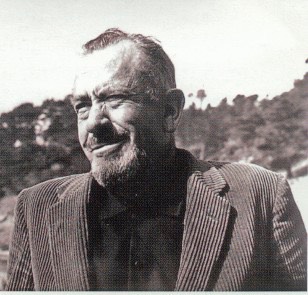I came to Steinbeck rather late in life as a result of reading The Grapes of Wrath followed by an extended visit to a relative in California which gave me the opportunity to explore Steinbeck territory — not only Salinas and Monterey, where he spent his early years and which provided the backgound to so much of his writing, but also Corral de Tierra, background to East of Eden, and Jolon, thought to be the inspiration for To A God Unknown.
Well aware of my position as an ingenue I sought help from the staff at the Steinbeck Center in Salinas on current scholarship, books and topics of interest, and discovered that Roy Simmonds seemed to be the only Englishman working in the field. On my return I set myself to explore the rest of Steinbeck’s output, leading to an attempt to come to grips with Steinbeck’s approach to religion in general and to Christianity and his use of biblical texts in particular (‘Rumour of God’), followed by my first excursion into print with Steinbeck’s ‘View of God’ in the Expository Times (March 2001), a more precise study covering some of the same ground from a different angle.
Research and Objective
Subsequent visits to California enabled further opportunities for research at San José and Stanford Universities, with much help and encouragement from Susan Shillinglaw, Director of the National Steinbeck Centre (seen above). With a lifetime of biblical and theological studies behind me and and the sudden, unexpected and unplanned joy of finding and exploring Steinbeck, two of many points grabbed my attention.
First, the connection between Steinbeck’s emphasis on the relationship between the individual and the community which rang bells for me of H Wheeler Robinson, a Baptist Oxford Old Testament professor who in the 1930s had wrestled with similar issues in the Old Testament, leading to my first contribution to Steinbeck Studies (March 2004).
Second, the hint from one scholar that the seam of biblical ideas and interpretations in Steinbeck was running out and that interest was moving on to Ricketts, the relationship between the two of them and their philosophical and religious presuppositions. This gave a new depth to my thinking on the individual and the community, turning my attention this time to Isaiah’s Suffering Servant. This provided the main peg for a hitherto unpublished paper (an abridged version of which I read at the Steinbeck Centennial Conference, 2002) and read subsequently to the Annual Bible and Literature Day at Sussex University, offering a different way of looking at the role Ricketts played in Steinbeck’s life. The article was rejected by one literary journal whose reader, I suspect, judging by his comments, had never quite grasped the biblical concept, but can now be found here.
By now it was becoming clear that Steinbeck scholars, with one or two exceptions such as Michael Meyer, were first and foremost literary folk, coming from churches with a good biblical tradition and for whom Steinbeck’s frequent biblical references, assumptions, suppositions and beliefs were a matter of considerable interest and importance. The steady flow of articles and books showed no sign of slowing down.
Biblical scholarship at the same time was changing as biblical criticism (also coming to the end of a line) gave way to biblical hermeneutics, with more emphasis on interpretation than origins and a growing readiness to turn to secular sources (poetry, novel, drama and, most recently, music) as a way of enabling the Bible to contribute to an understanding of the secular and the secular as a means to further enlightenment to the biblical text.
Steinbeck scholars and biblical scholars needed each other. Steinbeck scholars needed more biblical and theological input. Preachers and teachers needed the enrichment that Steinbeck and indeed other writers and dramatists could provide. If any explanation (or defence) of my chosen Steinbeck studies subsequently is needed that has to be it but it is more the fruit of serendipity than careful planning.
Serendipity
Much of what follows was the result of a chance encounter at the 2002 Centennial Conference with Michael J Meyer, a reputable Steinbeck scholar and also an altestamentler. Shortly afterwards I received an invitation from Mike to contribute to a volume he was editing on The Grapes of Wrath (2009). He wanted my ‘biblical insights’.
By this stage, as a Senior Research Fellow at the International Baptist Theological Seminary in Prague, one responsibility of which called for a Workshop for the benefit of Faculty and Post-graduate students on some aspect of applied theology not included in the curriculum, I saw fit to take 'A Fresh Look at Genesis 4:7 in the light of John Steinbeck, East of Eden', which at the same enabled me to respond to a second request from Mike Meyer for his next volume on that novel (2013).
Mike’s third request left me to choose the subject and this time I went for Steinbeck’s interest in Morte d’Arthur and his later writing, in particular The Winter of Our Discontent. Unfortunately, Mike’s untimely death came when Morte d’Arthur was nearing completion and the new editor and publisher had other ideas but Steinbeck Studies (2015) came to my rescue.
